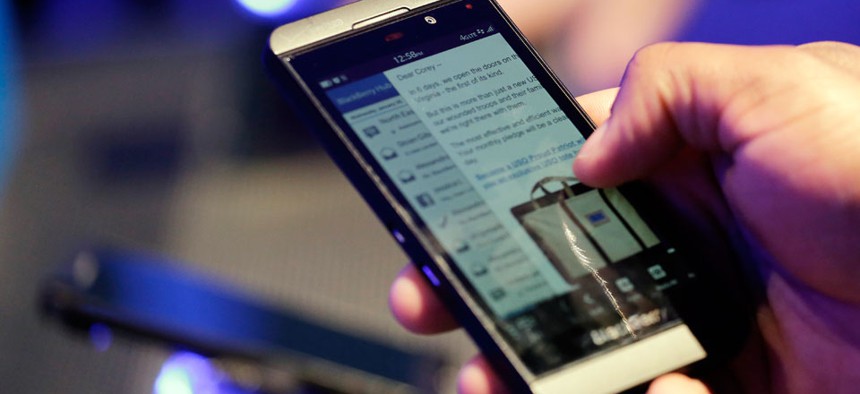Defense Readies Networks for Latest BlackBerrys

A person tries out the BlackBerry 10 Mark Lennihan/AP
Despite almost exiting the consumer market, the smartphones’ manufacturer is outfitting military networks with software to support the devices.
The Pentagon is outfitting military networks with software to support tens of thousands of BlackBerry Z10 and Q10 smartphones this year, according to the Defense Department and Blackberry officials who, in recent days, have announced the company will sharply scale back commercial sales.
Defense has one of the more sweeping plans among federal agencies to equip employees with brand-name mobile devices that can provide ubiquitous data access and custom apps. Before the Canadian company’s sales model shift, Defense already had sanctioned the BlackBerry 10 smartphones and BlackBerry PlayBook tablets for use on military networks.
Despite BlackBerry's new business direction, "to date, DoD has seen no impact to its Blackberry's services," Defense spokesman Lt. Col. Damien Pickart said in an email on Tuesday.
BlackBerry on Friday announced the new strategy, which hinges on sales to large enterprises, such as the federal government, rather than personal shoppers, who largely purchase Apple iPhones and mobile devices based on Google's Android operating system.
BlackBerry spokeswoman Kara Yi said in an email on Tuesday, "It remains our top priority to continue serving all our customers, including the DoD, and provide the same industry-leading quality products and services organizations have come to expect from BlackBerry."
The company still will face competition in the government sector, which typically follows consumer trends and would like to march in lockstep with them.
Defense Chief Information Officer Teri Takai stated in the department's overarching mobile device agenda, issued in 2012: "This strategy is not simply about embracing the newest technology -- it is about keeping the DoD workforce relevant in an era when information and cyberspace play a critical role in mission success."
About 9 million of the latest iPhone models flew off the shelves this past weekend, while the combined sales of all BlackBerry versions during the past three months only reached 5.9 million, according to company estimates.
BlackBerry officials on Tuesday downplayed their hardware business and pointed to recent work with Defense on mobile security software. Certain services can work on top of non-BlackBerry handhelds, including iPhones and Android smartphones, they added. "BlackBerry is much more than a device company," with software that protects phones at the "device, server and network level," Yi said.
The Canadian company last month gained permission to deploy its latest security services coupled with BlackBerry Z10 and BlackBerry Q10 smartphones on military networks. Defense "is now developing the infrastructure to support BlackBerry 10 smartphones," specifically 10,000 devices this fall and 30,000 by the end of 2013, officials said in a statement at the time.
iPhones, iPads and Samsung devices also have obtained approvals to operate on Defense networks, as part of a Defensewide shift from office workstations to government-owned gadgets of various makes and models.
Pickart said on Tuesday, “We are moving toward a secure mobile communications infrastructure that supports a variety of devices, to include BlackBerry. By establishing an agnostic, multi-vendor environment, we've minimized the impact of a single vendor to our current operations.”
In June, Pentagon officials purchased a potentially $16 million service for remotely securing devices in the hands of 300,000 military personnel worldwide. Neither the security nods nor the mobile protection service represent actual device purchases.
The Pentagon anticipates equipping 100,000 users with mobile devices by February 2014, and ultimately 600,000 military employees.
It remains to be seen how a potential sale of BlackBerry will impact all of the company’s customers. On Monday, the company tentatively agreed to be taken private under a $4.7 billion buyout deal led by Fairfax Financial Holdings.
NEXT STORY: Feds tiptoe toward in-memory computing






